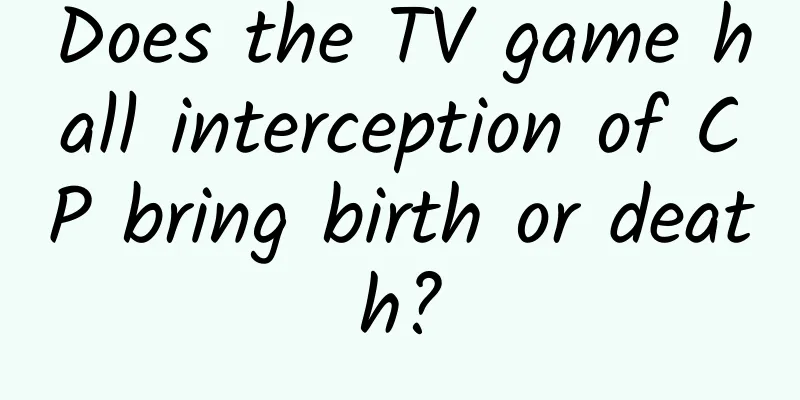Does the TV game hall interception of CP bring birth or death?

|
Searching for "TV game channel revenue sharing" on Baidu, the second place that appears is information about mobile game channel revenue sharing. Indeed, compared with the Chinese mobile game industry, which has an annual output value of US$5.5 billion, the development of China's TV game industry, which has been interrupted for 15 years, is still in an extremely early stage. Previously, due to the current situation of the industry being extremely poor, the industry had hardly discussed the distribution of benefits between channels and CPs, and more people took the approach of helping each other. After all, the distribution of benefits is only meaningful when it is based on a certain scale of benefits. When the industry is in a state of barrenness and hunger, it would be so unreasonable to say "Why not eat meat porridge?" Today, when the TV game industry is still in its infancy, a profit-sharing and retention model that transcends the industry's development rate is quietly emerging. This is definitely not good news for the TV game CPs that are just starting out. Hegel said that existence is reasonable. So, for the video game industry, which is still in its infancy, is it really reasonable to cut off the channels too early? The industry's early days Less than two years have passed since TV games revived in the domestic market. Initially, the mindset established from mobile game channels was directly applied to TV games. As a result, in 2013, TV game halls similar to mobile game download sites sprang up like mushrooms after rain; but in 2014, because the industry entered a trough and the tide receded, a number of naked game halls ceased operations. A large number of channels have entered the video game industry. To this day, the number of channels far exceeds that of CPs, and the situation of too many people and too little porridge has remained deadlocked. However, channels also need to survive, and even the smallest channels need to seek development. Some channels have begun to consider charging CPs. Regardless of the size of the channels or the number of them, when some channels began to reach out to CPs, the CPs’ answers were straightforward: “Forget it, just take my game off the shelves!” At present, although it is rare for channels to charge CPs, the different styles of each channel have already begun to emerge. The CPS (Cost Per Sale, which is calculated based on the actual number of products sold, equivalent to the channel taking a cut of the actual revenue of the CP) profit-sharing method adopted by game halls such as Dangbei, Qipo, Xiaomi, and Alibaba has always existed. Since this model is based on actual profits and does not bring additional pressure to the CP, most people keep a default attitude towards it. However, when some channels began to plan to "introduce" the CPA (Cost Per Action) model, the situation began to change. The CPA profit-sharing method has previously been common in applications such as pre-installation of games on hardware such as TV boxes and distribution of videos through channels. It is still a new thing in channel distribution. What good is A if there is no achievement to be achieved? It is understood that there are about 20 CPs specializing in TV games in China, and their overall turnover is very low, with a maximum of 100,000 turnover per month, and there is no way to talk about profitability. Even if some companies can get a little profit from operators, their survival is not good. Those channels that plan to increase CPA first should be very clear about this situation, so what are they planning to do with the profit-sharing model at this time? According to incomplete statistics, there are still more than 80 channel operators of various types in China's TV game industry, mainly including three major categories: operators, hardware manufacturers and third-party platforms. During the interview, we learned that the third-party game platform charges may be due to operating cost pressure. In addition to manpower and operations, it also includes the content distribution fees brought about by each game download; mature hardware companies face greater revenue pressure. According to industry insiders, due to the inability to profit from players, the huge pressure of internal KPI assessment has forced the game hall operation team to target CP. Industry insiders pointed out that compared with the CPS model where the risk is shared by the channel and the CP, other models such as CPA and CPT (Cost Per Try) have stronger limitations. It is not only difficult to make money but also difficult to sustain when the game acceptance is limited. During the investigation, it was found that the support of the majority of TV game CPs for this practice is almost zero. Some CPs clearly stated that they have not made any money yet, so it is better not to cooperate than to use CPA. So the question is, if CPA becomes a trend, will it have a devastating impact on the already small number of TV game manufacturers? According to insiders, several manufacturers have withdrawn from the TV game industry this year, which is more than the number of the whole year last year. The current revenue of TV games is indeed not enough to attract developers who are making a fortune in the mobile game industry. If the channels still want to take advantage of the opportunities, the CPs will probably be disappointed. The time is not right, the loss is not worth the gain From the analysis above, we can see that the change of profit-sharing model will undoubtedly increase the pressure on CP to survive. So is this a profitable thing for the channel? Currently, there is no consensus among channel operators on the profit-sharing model, but if the CPS model is sustainable, only a few game halls will plan to try the CPA model. CP has the right to independently choose its cooperation channels, and coupled with the subsidy policies of some platforms, launching the CPA model now may just push CP towards its competitors. Furthermore, if all platforms adopt the CPA model now, domestic TV game development may be stranded or even regress. When the TV game wave really arrives, the platform may only be able to introduce foreign game resources, and the cost should be much higher than the current cost of maintaining normal channel operations. According to statistics from industry insiders, there are less than 200 TV games in China, and only 2-3 new games are added each month. The operating costs paid by the platform are not too much pressure. What is even more fatal is that the channel's charging of CPs may push TV games to profit from players, but the time is not yet ripe. A senior player pointed out that the current TV game user base is small and low-quality, like a closed oil and salt shop. Before the player group is formed, premature payment may cause user evaporation, directly curbing the development of TV games from the source. It can be seen that even if the lobby has alleviated some of the revenue pressure through the new profit-sharing model, it may only be a very short-lived illusion. From the experience of mobile games, we can also see that no matter how strong the channel is, it is based on the CP's sufficient profitability, and the distribution of mobile games must also consider many issues such as the CP's copyright fees. This reflects that the development of TV games has not yet entered the stage where the details of profit distribution need to be considered. In fact, the TV game industry, which is in its infancy, faces challenges in terms of device penetration, game content, payment conversion rate, etc. CPs are most concerned about issues directly related to user experience, such as control and adaptation. After all, the ultimate goal is to get players to buy in. We may not know the original intentions behind different corporate decisions, but there is no doubt that channels and CPs are grasshoppers on the same rope. The idea of some game halls hoping to get some money from CPs right now will not promote the development of the industry. On the contrary, this move is tantamount to strangling the TV game in its cradle. TV games have just sprouted and need the joint care of channels and CPs; without cash inflow, it is meaningless to classify, discuss or try the profit-sharing model. At this stage, the consensus in the industry is to seek a way out under the premise of balance and stability. Finally, to borrow a phrase from the CEO of a gaming hall, I hope everyone can survive before smart TVs explode, rather than fighting to the death!
As a winner of Toutiao's Qingyun Plan and Baijiahao's Bai+ Plan, the 2019 Baidu Digital Author of the Year, the Baijiahao's Most Popular Author in the Technology Field, the 2019 Sogou Technology and Culture Author, and the 2021 Baijiahao Quarterly Influential Creator, he has won many awards, including the 2013 Sohu Best Industry Media Person, the 2015 China New Media Entrepreneurship Competition Beijing Third Place, the 2015 Guangmang Experience Award, the 2015 China New Media Entrepreneurship Competition Finals Third Place, and the 2018 Baidu Dynamic Annual Powerful Celebrity. |
<<: SMMT: UK new car registrations fell 4.4% in September 2020
>>: NIO: Deliveries exceeded 5,000 units for the first time in October 2020
Recommend
Tips for flooding the screen with Wechat Loan’s new customer acquisition activities!
I’m sure you were all flooded with messages about...
2021CP Circle Report: New Brand Play!
In the "2021 CP Circle Marketing Report"...
Academician Zhong Nanshan: During the epidemic, it is very important to protect your immunity!
Reviewer of this article: Chen Haixu, Deputy Dire...
Deloitte Consulting: 2025 China Life Sciences and Healthcare Industry Research Report
The survey covers multiple areas, including busin...
How much does it cost to attract investment for Benxi Home Furnishing Mini Program?
How much does it cost to attract investment for t...
Two dimensions teach you how to spread high-quality content?
In an era where content is king, the value of hig...
Is it expensive to develop a Sanya nail art mini program? Sanya nail art applet development cost and process
Sanya nail art applet development price 1. Displa...
The most common pitfalls when promoting new products
The marketing strategy of a product must go with ...
A “guide” to wasting money on advertising: How to spend 100 yuan like 1 yuan?
There is a famous saying in the advertising indus...
How to make an executable product promotion plan?
A few days ago, a friend who studied abroad (retu...
Jacky Cheung Resume: What is anchor text? How does anchor text help SEO?
Anchor text construction is an important aspect o...
A congenitally blind man can "see" the flying ball without using his eyes
Produced by: Science Popularization China Produce...
If you want users to click on your ads, try these 5 methods!
We have to admit that we live in an age where adv...
How to make a birthday blessing video for African children and a short video of foreign birthday shouting?
Every birthday is a sign of our growth, so of cou...
3 ways to increase user traffic!
User growth has always been a key to business ope...









